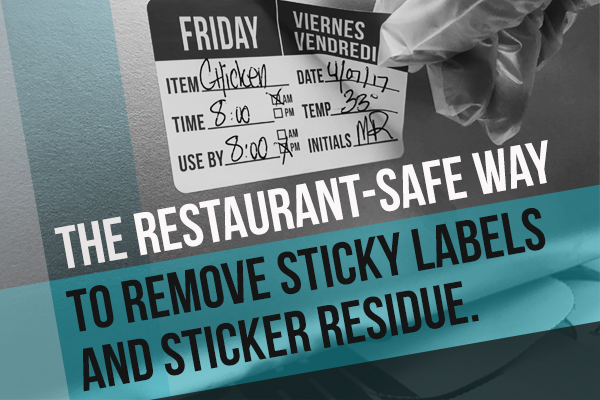The Restaurant-Safe Way to Remove Sticky Labels & Sticker Residue

All kitchen waitstaff can empathize with having to scrape sticky residue off of food prep and storage containers - hours spent painstakingly soaking, rubbing, and scraping sticker residue off of pots and pans. It’s a job no one wants to do, and using harsh chemicals in a foodservice environment is off limits, making the task even more difficult. Read our tips below for the best ways to remove sticker residue from plastic and metal food containers.
What Not to Use
Because the labels are used in a kitchen environment where food products are prepared and stored, you would NOT want to use things like nail polish remover (acetone) or WD-40, which are commonly suggested to remove sticker residue. Harsh chemicals like this are not safe for food prep areas.
How to Remove Sticker Residue
Employ these methods for removing sticker residue that are kitchen and restaurant-safe.- Use cooking oil. Any kind of cooking oil will work - olive oil, canola oil, or vegetable oil. Submerge the plastic in cooking oil for 12-24 hours. The oil will soak into the adhesive and make it easier to remove sticker residue.
- Use baking soda and cooking oil or water. Baking soda is non-toxic and restaurant-safe, making it a great solution for removing sticker residue in kitchen settings. Make a paste out of equal parts baking soda and cooking oil. Apply the paste to the label for about 5 minutes and wipe away the paste. The time it requires to soften the adhesive is dependent on the adhesive backing of the sticker, so it may take some trial and error to get the timing down.
- Apply heat. If the container is plastic, use a hair dryer to soften the label adhesive. Most hair dryers can reach 131° F, which is hot enough to soften the adhesive, but not hot enough to melt the plastic containers. If the container is glass, you can use the oven on a low setting to soften the adhesive. Then, gently rub or scrape the residue off the container.
- Use peanut butter. If cooking oil isn’t available, peanut butter will also work. The oils in the peanut butter will seep into the label adhesive and loosen it from the container.
- Use a knife or sharp edge. When all else fails, using a flat-edge knife can also work to scrape off sticker residue. Just be careful to not scratch the container.
Removing Sticker Residue from Plastic Containers
You can employ the same tactics to remove sticker residue from plastic containers as mentioned above.- Use oils.
- Use baking soda.
- Soak in warm water.
- Apply heat.
- Use a scouring pad or sharp edge.
It can be difficult to completely remove sticker residue from plastic containers, especially when using strong adhesives. The good thing about plastic containers is that they are relatively inexpensive to replace should you be unable to completely clean the container.
Great, but what about next time?
Instead of using labels with strong, permanent adhesives, there are label materials available that make it easy to remove labels with no sticky residue. For your next food rotation label purchase, consider using these label material types:
Dissolve It - Labels Dissolve in 30 Seconds
 Dissolve It is a dissolvable label material that washes away in under 30 seconds under any water temperature. Since the label dissolves completely, there’s never any sticky residue left behind.
Dissolve It is a dissolvable label material that washes away in under 30 seconds under any water temperature. Since the label dissolves completely, there’s never any sticky residue left behind.
Mighty Peel - Plastic, Removable Labels
 Mighty Peel is a durable, plastic material with a special removable adhesive that allows the label to remove cleanly every time. Mighty Peel labels are water resistant and can be repositioned, also leaving no sticky residue behind.
Mighty Peel is a durable, plastic material with a special removable adhesive that allows the label to remove cleanly every time. Mighty Peel labels are water resistant and can be repositioned, also leaving no sticky residue behind.
Ultra Removable - Paper, Removable Labels
 Ultra Removable labels are similar to Mighty Peel labels in that they can be repositioned and remove cleanly, but they have a basic paper face instead of a plastic face, so they are more economical.
Ultra Removable labels are similar to Mighty Peel labels in that they can be repositioned and remove cleanly, but they have a basic paper face instead of a plastic face, so they are more economical.
Having trouble with sticky residue on plastic or metal containers?
Contact Dot It for label solutions that will eliminate the need to scrub labels off food prep containers again.
